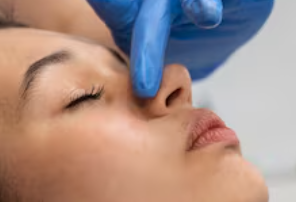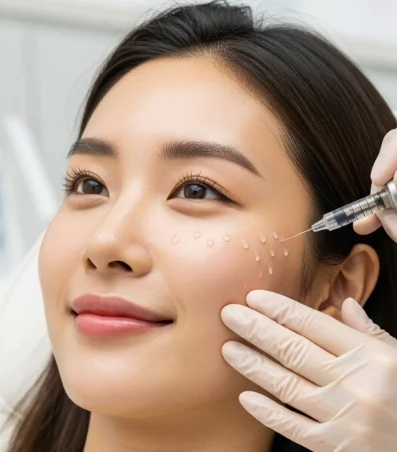Treatment Overview
Defined Nose Bridge Enhancement in Korea is a highly sought-after non-surgical cosmetic procedure that uses injectable fillers—primarily hyaluronic acid (HA) fillers—to refine and lift the nasal bridge. Often described as a “liquid rhinoplasty,” this treatment offers an alternative to traditional surgical rhinoplasty for patients seeking a more elevated, straighter, and sharper nose profile without the risks and downtime of surgery.
Korea has become a world leader in this field, combining advanced filler technology, micro-cannula techniques, and artistry to deliver results that are both natural and safe. The focus is on balance and harmony—a well-defined nasal bridge that complements the patient’s facial proportions, rather than creating an exaggerated or artificial look.
Purpose & Benefits
The main goal of Defined Nose Bridge Enhancement is to add height, symmetry, and definition to the nasal bridge. This subtle yet effective treatment can bring dramatic improvements to overall facial aesthetics. Benefits include:
- Refined Nasal Profile: Elevates and sharpens the bridge, making the nose appear longer and more defined.
- Correction of Irregularities: Smooths out small bumps, indentations, or asymmetry.
- Non-Surgical Alternative: Avoids invasive rhinoplasty, anesthesia, and long recovery times.
- Natural-Looking Results: Enhances beauty while maintaining harmony with other features.
- Customizable & Reversible: Fillers can be adjusted or dissolved if needed.
- Quick & Convenient: Procedures are typically completed within 30–40 minutes.
- Minimal Downtime: Patients can return to daily life immediately after treatment.
For many, this treatment is not only a cosmetic enhancement but also a confidence-boosting solution.
Ideal Candidates
Defined Nose Bridge Enhancement in Korea is best suited for individuals who:
- Have a flat or low nasal bridge and desire more definition.
- Want to correct small nasal irregularities without surgery.
- Prefer subtle, temporary, and reversible results.
- Are looking for an affordable and non-invasive alternative to rhinoplasty.
- Wish to improve facial balance and achieve a more refined aesthetic.
It is not ideal for patients who require major reshaping, structural changes, or functional improvements such as correcting breathing difficulties. In those cases, surgical rhinoplasty may be necessary.
Techniques Used in Korea
Korean dermatologists are recognized worldwide for their precise and innovative filler injection methods. Common techniques include:
- Micro-Cannula Method: Minimizes trauma, reduces bruising, and ensures safer filler placement.
- Layered Filler Injection: Small amounts of filler are placed strategically along the bridge for even definition.
- Hyaluronic Acid Fillers: Soft, moldable, and biocompatible materials are preferred for safety and reversibility.
- Artistic Proportioning: Specialists apply the “golden ratio” principle, creating a natural balance between the forehead, nose, and chin.
- Ultrasound-Guided Injections (at select clinics): Ensures safe injection depth and avoids vascular complications.
This emphasis on safety, precision, and artistry has made Korea a trusted destination for nose enhancement procedures.
Recovery & Aftercare
Recovery from this treatment is minimal, making it ideal for busy patients and international visitors. Aftercare instructions generally include:
- Avoid pressing, rubbing, or massaging the treated area for 24–48 hours.
- Skip strenuous exercise, alcohol, or sauna/steam rooms for 1–2 days.
- Sleep with the head elevated for the first night to reduce swelling.
- Use cold compresses if mild swelling or bruising appears.
- Follow-up visits may be recommended to assess results or make adjustments.
Most patients resume work or social activities immediately after treatment.
Results & Longevity
- Immediate Results: The nasal bridge looks sharper and more refined right after the procedure.
- Final Refinement: Subtle swelling resolves within a few days, revealing the final shape.
- Longevity: Typically lasts 9 to 15 months, depending on filler type and individual metabolism.
- Maintenance: Annual touch-ups are common for patients who want to maintain results long term.
One of the biggest advantages of fillers is flexibility—patients can enhance, adjust, or reverse the treatment as their preferences change.
Risks & Safety Considerations
Although considered safe, possible side effects may include:
- Temporary redness, swelling, or bruising.
- Mild tenderness at the injection site.
- Rare but serious risks like vascular occlusion if improperly injected.
Korean clinics minimize these risks by using premium filler brands, advanced safety protocols, and highly trained specialists.
Cost of Defined Nose Bridge Enhancement in Korea
- Per syringe: 350,000 – 700,000 KRW ($260 – $510 USD)
- Full session: 700,000 – 1,200,000 KRW ($520 – $900 USD)
Costs vary depending on clinic reputation, location, and the type of filler used.
Popular Clinics in Korea for Nose Bridge Enhancement
- Banobagi Plastic Surgery Clinic (Seoul): Offers advanced filler techniques for precise contouring.
- ID Hospital (Seoul): Specializes in both surgical and non-surgical rhinoplasty.
- Oracle Dermatology Clinic: Known for foreigner-friendly services and minimally invasive care.
- JW Plastic Surgery Clinic: Experts in achieving natural results with safe filler applications.
- Cheongdam Renew Clinic: Popular among international patients seeking natural, defined enhancements.




